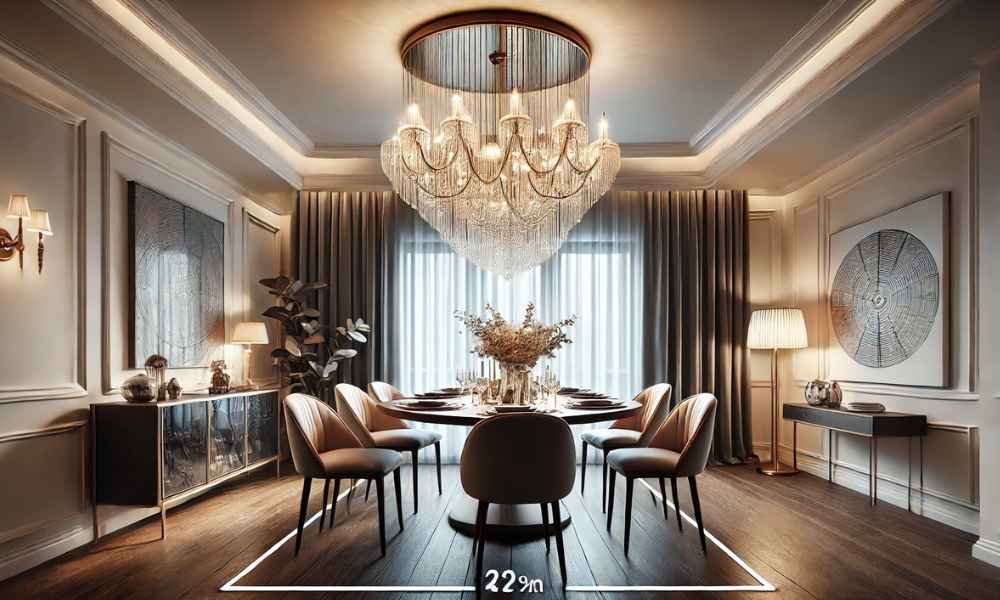A chandelier serves as more than just a light source—it is the focal point of a dining room, bringing elegance and warmth to the space. However, improper placement can make even the most luxurious candlestick look out of place. If hung too high, it may fail to provide adequate lighting and feel disconnected from the room’s ambiance. Too low, and it might obstruct sightlines or overwhelm the table. Striking the perfect balance is essential for both aesthetics and functionality. High Should A Chandelier Be Above A Dining Room Table.
Understanding the Ideal Chandelier Height
The commonly recommended height for a candlestick above a dining table is between 30 to 36 inches from the tabletop. This standard ensures that the light is evenly distributed across the dining surface while maintaining an inviting atmosphere. However, several factors, such as ceiling height, chandelier size, and room proportions, influence this placement.
Calculating the Perfect Chandelier Height
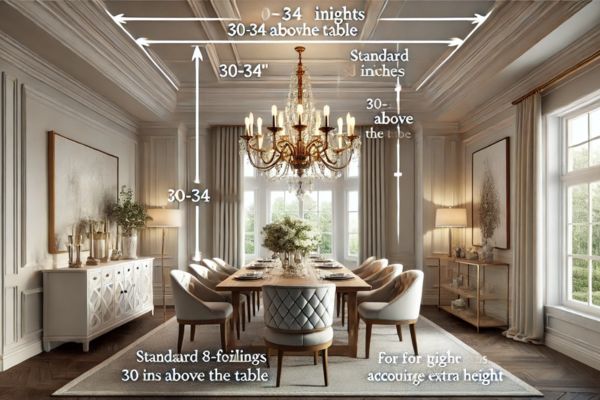
Determining the right height requires a blend of general guidelines and personalized adjustments. A good rule of thumb is:
- For standard 8-foot ceilings, hang the candlestick 30-34 inches above the table.
- For higher ceilings, add an extra 3 inches per additional foot of ceiling height.
- If the chandelier is exceptionally large or elaborate, it may need to be slightly higher to avoid overwhelming the space.
Additionally, the chandelier’s height should allow for comfortable eye contact across the table, avoiding any unnecessary glare while dining.
Chandelier Size and Its Impact on Height Placement
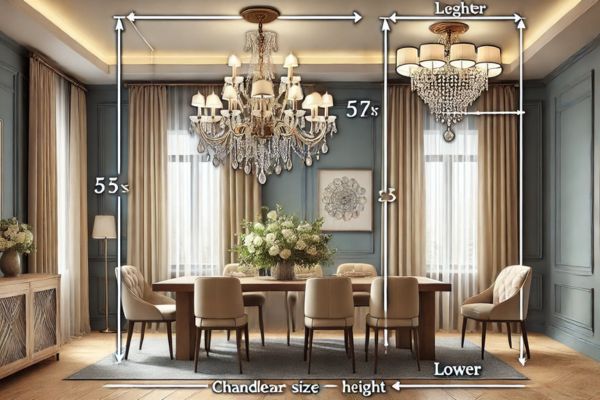
A chandelier’s dimensions significantly influence its positioning. A larger candlestick demands a slightly higher placement to prevent it from dominating the space, whereas a smaller fixture can be positioned lower to maintain intimacy. The general formula for candlestick width is half to two-thirds the width of the dining table to maintain proper scale and proportion.
If the chandelier has an open, airy design, such as one with minimal framework and exposed bulbs, it can be hung a bit lower without feeling overwhelming. In contrast, dense or heavily adorned fixtures may require additional height clearance.
Ceiling Height Considerations
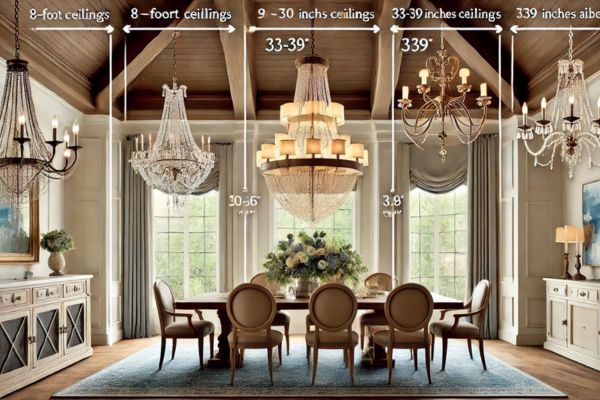
Ceiling height plays a pivotal role in determining the chandelier’s ideal hanging position.
- Standard 8-foot ceilings: Follow the 30-36 inch guideline from the tabletop.
- 9 to 10-foot ceilings: Position the candlestick around 33-39 inches from the table.
- Vaulted or cathedral ceilings: The candlestick should be anchored lower than usual, potentially using chain extensions to ensure it remains at an optimal distance from the table while maintaining visual cohesion.
For rooms with exceptionally high ceilings, a multi-tiered chandelier can help fill the vertical space without making the fixture appear too distant.
Dining Room Table Size and Shape Matters
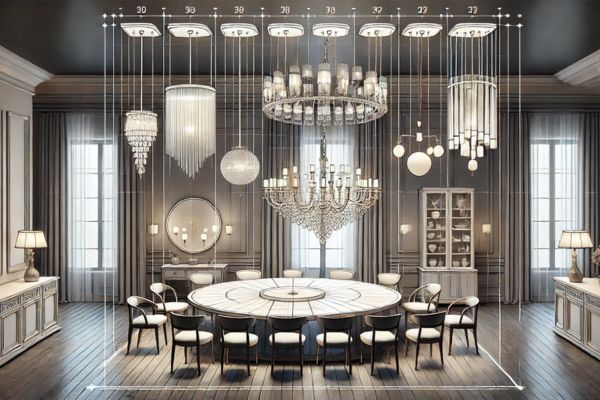
The table’s size and shape also influence chandelier placement. A long rectangular table may require either an elongated candlestick or multiple pendant lights to ensure proper illumination.
- For round or square tables, a centrally positioned chandelier works best.
- For rectangular tables, a linear chandelier or a pair of fixtures maintains balance.
Regardless of shape, ensure that the candlestick extends no further than 6 inches from the edge of the table on either side to avoid feeling disproportionate.
Chandelier Style and Design Influence

The style of a candlestick significantly impacts its ideal height above the dining table. Traditional, ornate chandeliers with cascading crystals tend to command more visual weight, which often necessitates slightly higher placement to prevent overwhelming the space. On the other hand, sleek, modern chandeliers with minimalist designs can be positioned slightly lower without disrupting the room’s balance. Open-frame designs allow light to disperse freely, while enclosed fixtures may cast a more focused glow, requiring strategic placement to ensure even lighting. Ultimately, selecting a candlestick height that complements its design enhances both aesthetics and usability.
Lighting Intensity and Adjustability
A chandelier’s height directly affects how well it illuminates the dining area. Hanging it too high can result in insufficient lighting, leaving the table dim and uninviting. Conversely, if it’s too low, the lighting may become harsh, causing glare and discomfort. To counteract these issues, installing a dimmer switch allows you to adjust brightness levels based on the occasion—whether it’s an intimate dinner or a lively gathering. Additionally, layering light sources with wall sconces, recessed lighting, or pendant lights ensures a well-balanced ambiance that adapts to various needs.
Safety and Practicality Considerations
While aesthetics play a major role in candlestick placement, safety and practicality should not be overlooked. A fixture hanging too low risks accidental head bumps, especially in homes with active children or tall individuals. It’s also crucial to ensure the chandelier doesn’t obstruct views across the table, particularly in open-concept spaces where sightlines matter. Additionally, proper electrical wiring and support are essential to secure the candlestick, preventing hazards such as loosening chains or unstable fixtures. Always verify that the ceiling can handle the chandelier’s weight before installation.
Customizing Chandelier Height for Special Occasions
While the 30-36 inch rule serves as a general guideline, certain occasions may call for adjustments. For formal dinner parties, lowering the candlestick slightly can create an intimate ambiance, emphasizing a warm and cozy atmosphere. During festive seasons, when centerpieces and decorative arrangements are prominent, slightly raising the fixture prevents overcrowding the visual space. In settings where flexible lighting is preferred, adjustable chandeliers with retractable cords or telescopic rods provide a convenient solution, allowing for easy height modifications when needed.
Common Chandelier Hanging Mistakes to Avoid
Many homeowners make the mistake of hanging a candlestick either too high or too low, disrupting the harmony of the dining area. Hanging it too low creates a claustrophobic effect, making the table feel cramped, while placing it too high diminishes its impact, leaving the space feeling empty. Another common error is ignoring the chandelier’s proportion to the table—oversized fixtures demand extra clearance, while smaller chandeliers may require lower positioning to make a statement. Additionally, failing to consider room proportions can lead to a disjointed look, where the candlestick appears out of place within the dining room.
Installation Tips and Tricks
For a flawless installation, start by measuring the dining table’s width and length to determine the appropriate chandelier size and placement. The fixture should generally be about half to two-thirds the width of the table. Use a sturdy ceiling mount and ensure the wiring is properly connected to support the fixture’s weight. A candlestick with an adjustable chain or rod offers greater flexibility, allowing minor height modifications after installation. If unsure, hiring a professional ensures safe and accurate placement, avoiding potential electrical hazards or structural mishaps.
Chandelier Alternatives and Complementary Lighting
A traditional candlestick doesn’t suit your space, several stylish alternatives can provide similar elegance and functionality. Pendant lights, especially in clusters or linear arrangements, create a modern, dynamic look while offering customizable height options. For a softer, diffused glow, recessed lighting combined with wall sconces adds depth and dimension to the room. Additionally, table and floor lamps can serve as secondary light sources, preventing the dining space from relying solely on overhead illumination.
Final Thoughts
Determining how high a chandelier should be above a dining room table is about striking the perfect balance between form and function. While general guidelines provide a starting point, factors such as ceiling height, candlestick style, and room layout should guide the final decision. Whether enhancing ambiance, ensuring adequate lighting, or preventing safety concerns, proper placement elevates both the aesthetic appeal and practicality of the dining space. By following these expert tips, you can create a warm, inviting environment that complements your home’s overall design.
